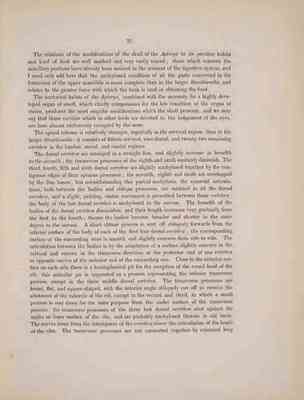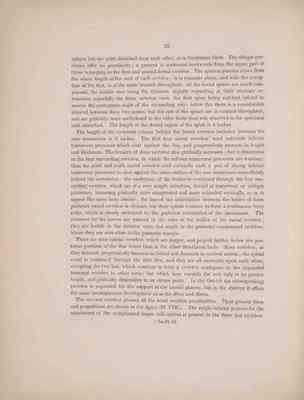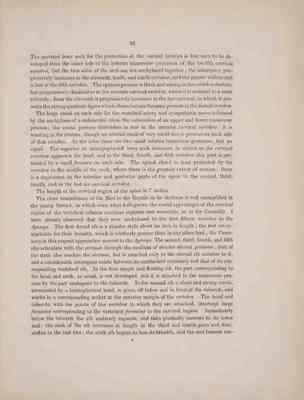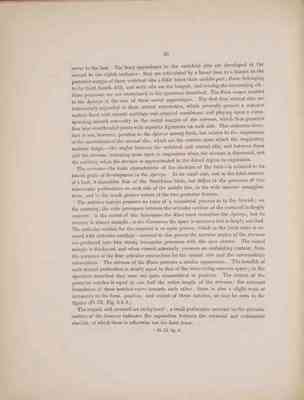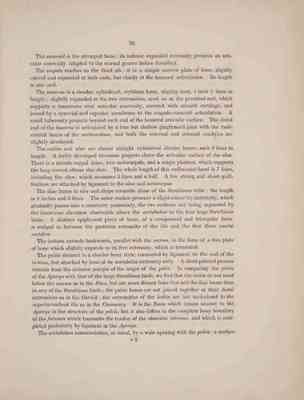Pages
51
31
The relations of the modifications of the skull of the Apteryx to its peculiar habits and kind of food are well marked and very easily traced ; those which concern the maxillary portions have already been noticed in the account of the digestive system, and I need only add here that the anchylosed condition of all the parts concerned in the formation of the upper mandible is more complete than in the larger Struthionidoe, and relates to the greater force with which the beak is used in obtaining the food.
The nocturnal habits of the Apteryx, combined with the necessity for a highly developed organ of smell, which chiefly compensates for the low condition of the organ of vision, produces the most singular modifications which the skull presents, and we may say that those cavities which in other birds are devoted to the lodgement of the eyes, are here almost exclusively occupied by the nose.
The spinal column is relatively stronger, especially in the cervical region, than in the larger Struthionidoe : it consists of fifteen cervical, nine dorsal, and twenty-two remaining vertebrae in the lumbar, sacral and caudal regions.
The dorsal vertebrae are arranged in a straight line, and slightly increase in breadth to the seventh ; the transverse processes of the eighth and ninth suddenly diminish. The third, fourth, fifth and sixth dorsal vertebrae are slightly anchylosed together by the contiguous edges of their spinous processes ; the seventh , eighth and ninth are overlapped by the iliac bones ; but notwithstanding this partial anchylosis, the synovial articulations, both between the bodies and oblique processes, are retained in all the dorsal vertebrae, and a slight, yielding, elastic movement is permitted between those vertebrae : the body of the last dorsal vertebra is anchylosed to the sacrum. the breadth of the bodies of the dorsal vertebra diminishes, and their length increases very gradually from the first to the fourth ; thence the bodies become broader and shorter in the same degree to the sacrum. A short obtuse process is sent off obliquely forwards from the inferior surface of the body of each of the first four dorsl vertebrae ; the corresponding surface of the succeeding ones is smooth and slightly concave from side to side. The articulation between the bodies is by the adaptation of a surface slightly concave in the vertical and convex in the transverse direction at the posterior end of one vertebra to opposite surves at the anterior end of the succeeding one. Close to the anterior surface on each side there is a hemispherical pit for the reception of the round head of the rib : this articular pit is supported on a process representing the inferior transverse process, except in the three middle dorsal vertebrae. The transverse processes are broad, flat, and square-shaped, with the anterior angle obliquely cut off to receive the abutment of the tubercle of the rib, except in the second and third, in which a small process is sent down for the same purpose from the under surface of the transverse process : the transverse processes of the three last dorsl vertebrae abut against the under or inner surface of the ilia, and are probably anchylosed thereto in old birds. The nerves issue from the interspaces of the vertebrae above the articulation of the heads of the ribs. The transverse processes not not connected together by extended long
52
32
splints, but are quite detached from each other, as in Struthious birds. the oblique processes offer no peculiarity ; a process is continued backwards from the upper part of those belonging to the first and second dorsal vertebrae. The spinous process arises from the whole length of the arch of each vertebra ; it is truncate above , and with the exception of the first , is of the same breadth throughout : all the dorsal spines are much compressed, the middle ones being the thinnest, slightly expanding at their truncate extremities, especially the three anterior ones, the first spine being notched behind to receive the contiguous angle of the succeeding one : below this there is a considerable interval between these two spines, but the rest of the spines are in contact throughout, and are probably more anchylosed in the older birds than was observed in the specimen here described. The length of the dorsal region of the spine is 4 inches.
The length of the vertebral column behind the dorsal vertebrae included between the ossa innominata is 3 inches. The first four sacral vertebrae 1 send outwards inferior transverse processes which abut against the ilia, and progressively increase in length and thickness. The breadth of these vertebrae also gradually increases ; but it diminishes in the four succeeding vertebrae, in which the inferior transverse processes are wanting : then the ninth and tenth sacral vertebrae send outwards each a pair of strong inferior transverse processes to abut against the inner surface of the ossa innominata immediately behind the acetabulum : the anchylosis of the bodies is continued through the four succeeding vertebrae, which are of a very simple structure, devoid of transverse or oblique processes, becoming gradually more compressed and more extended vertically, so as to appear like mere bony laminae ; the line of the articulation between the bodies of these posterior sacral vertebrae is obvious, but their spines coalesce to form a continuous bony ridge, which is closely embraced by the posterior extremities of the innominata. The foramina for the nerves are pierced in the sides of the bodies of the sacral vertebrae ; they are double in the anterior ones, but single in the posterior compressed vertebrae, where they are seen close to the posterior margin.
There are nine caudal vertebrae, which are deeper, and project farther below the posterior portions of the iliac bones than in the other Struthious birds : these vertebrae, as they descend, progressively increase in lateral and diminish in vertical extent ; the spinal canal is continued through the first five, and they are all moveable upon each other, excepting the two last, which combine to form a vertebra analogous to the expanded terminal vertebra in other birds, but which here exceeds the rest only in its greater length, and gradually diminishes to an obtuse point. In the Ostrich the corresponding vertebra is expanded for the support of the caudal plumes, but in the Apteryx it offers the same inconspicuous development as in the Rhea and Emeu.
The cervical vertebrae present all the usual ornithic peculiarities. Their general form and proportions are shown in the figure (Pl. VIII.). The single inferior process for the attachment of the complicated longus colli anticus is present in the three last vertebrae.
1 See Pl. IX.
53
33
The inverted bony arch for the protection of the carotid arteries is first seen to be developed from the inner side of the inferior transverse processes of the twelfth cervical vertebra, but the two sides of the arch are anchylosed together ; the interspace progressively increases in the eleventh, tenth and ninth vertebrae, and the groove widens and is lost at the fifth vertebra. The spinous process is thick and strong in the vertebra dentata, but progressively diminishes to the seventh cervical vertebra, where it is reduced to a mere tubercle ; from the eleventh it progressively increases to the last cervical, in which it presents the strong quadrate figure which characterizes the same process in the dorsal vertebrae.
The large canal on each side for the vertebral artery and sympathetic nerve is formed by the anchylosis of a rudimental rib to the extremities of an upper and lower transverse process ; the costal process diminishes in size in the anterior cervical vertebrae : it is wanting in the dentata, though an arterial canal of very small size is present on each side of that vertebra. In the atlas there are two small inferior tranverse processes, but no canal. the superior or neurapophysial bony arch increases in extent as the cervical vertebrae approach the head, and in the third, fourth and fith vertebrae this part is perforated by a small foramen on each side. The spinal chord is least protected by the vertebrae in the middle of the neck, where there is the greatest extent of motion : there is a depression on the anterior and posterior parts of the spine in the second, third, fourth, and in the last six cervical vertebrae.
The length of the cervical region of the spine is 7 inches.
The close resemblance of the Bird to the Reptile in its skeleton is well exemplified in the young Ostrich, in which even when half-grown the costal appendages of the cervical region of the vertebral column continue separate and moveable, as in the Crocodile. I have already observed that they were anchylosed to the first fifteen vertebrae in the Apteryx. The first dorsal rib is a slender style about an inch in length ; the rest are remarkable for their breadth, which is relatively greater than in any other bird ; the Cassowary in this respect approaches nearest to the Apteryx. The second, third, fourth, and fifth ribs articulate with the sternum through the medium of slender sternal portions ; that of the sixth also reaches the sternum, but is attached only to the sternal rib anterior to it, and a considerable interspace exists between its unattached extremity and that of its corresponding vertebral rib. In the first simple and floating rib, the part corresponding to the head and neck, as usual, is not developed, and it is attached to the transverse process by the part analogous to the tubercle. In the second rib a short and strong cervix, terminated by a hemispherical head, is given off below and in front of the tubercle, and works in a corresponding socket at the anterior margin of the vertebra. The head and tubercle, with the points of the vertebrae to which they are attached, intercept large foramina corresponding to the vertebral foramina in the cervical region. Immediately below the tubercle the rib suddenly expands, and then gradually narrows to its lower end : the neck of the rib increases in length in the third and fourth pairs and diminishes in the last two ; the sixth rib begins to lose its breadth, and the rest become nar-
F
54
34
rower to the last. The bony appendages to the vertebral ribs are developed in the second to the eighth inclusive : they are articulated by a broad base to a fissure in the posterior margin of these vertebral ribs a little below their middle part ; those belonging to the third, fourth, fifth and sixth ribs are the longest, and overlap the succeeding rib : these processes are not anchylosed in the specimen described. The Rhea comes nearest to the Apteryx in the size of these costal appendages. The first four sternal ribs are transversely expanded at their sternal extremities, which severally present a concave surface lined with smooth cartilage and synovial membrane, and playing upon a corresponding smooth convexity in the costal margin of the sternum, which thus presents four true enarthrodial joints with capsular ligaments on each side. This elaborate structure is not, however, peculiar to the Apteryx among birds, but relates to the importance of the movements of the sternal ribs, which are the centres upon which the respiratory motions hinge, - the angles between the vertebral and sternal ribs, and between these and the sternum, becoming more open in inspiration when the sternum is depressed, and the contrary when the sternum is approximated to the dorsal region in expiration.
The sternum - the main characteristic of the skeleton of the bird - is reduced to its lowest grade of development in the Apteryx. In its small size, and in the total absence of a keel, it resembles that of the Struthious birds, but differs in the presence of two subcircular perforations on each side of the middle line, in the wide anterior emarginations, and in the much greater extent of the two posterior fissures.
The anterior margin presents no trace of a manubrial process as in the Ostrich : on the contrary, the wide interspace between the articular cavities of the coracoid is deeply concave : in the extent of this interspace the Rhea most resembles the Apteryx, but its contour is almost straight ; in the Cassowary the space is narrower but is deeply notched. The articular surface for the coracoid is an open groove, which in the fresh state is covered with articular cartilage : external to this groove the anterior angles of the sternum are produced into two strong triangular processes with the apex obtuse. The costal margin is thickened, and when viewed anteriorly, presents an undulating contour, from the presence of the four articular convexities for the sternal ribs and the intermediate excavations. the sternum os the Emeu presents a similar appearance. The breadth of each sternal perforation is nearly equal to that of the intervening osseous space : in the specimen described they were not quite symmetrical in position. The extent of the posterior notches is equal to one half the entire length of the sternum : the external boundaries of these notches curve towards each other : there is also a slight want of symmetry in the form, position, and extent of these notches, as may be seen in the figures (Pl. IX. Fig. 2 & 3.)
The scapula and coracoid are anchylosed 1 : a small perforation anterior to the articular surface of the humerus indicates the separation between the coracoid and rudimental clavicle, of which there is otherwise not the least trace.
1 Pl. IX.fig.4
55
35
The carocoid is the strongest bone: its inferior expanded extremity presents an articular convexity, adapted to the sternal groove before described.
The scapula reaches to the third rib : it is a simple narrow plate of bone, slightly curved and expanded at both ends, but chiefly at the humeral articulation. Its length is one inch.
The humerus is a slender, cylindrical, styliform bone, slightly bent, 1 inch 5 lines in length ; slightly expanded at the two extremities, most so at the proximal end, which supports a transverse oval articular convexity, covered with smooth cartilage, and joined by a synovial and capsular membrane to the scapulo-coracoid articulation. A small tuberosity projects beyond each end of the humeral articular surface. The distal end of the humerus is articulated by a true but shallow ginglymoid joint with the rudimental bones of the antibrachium, and both the external and internal condyles are slightly developed.
The radius and ulna are almost straight cylindrical slender bones, each 9 lines in length. A feebly developed olecranon projects above the articular surface of the ulna. There is a minute carpal bone, two metacarpals, and a single phalanx, which supports the long curved obtuse alar claw. The whole length of this rudimental hand is 7 lines, including the claw, which measures 3 lines and a half. A few strong and short quillfeathers are attached by ligament to the ulna and metacarpus.
The iliac bones in size and shape resemble those of the Struthious tribe : the length is 4 inches and 3 lines. the outer surface presents a slight concavity anteriorly which gradually passes into a convexity posteriorly, the two surfaces not being separated by the transverse elevation observable above the acetabulum in the four large Struthious birds. A distinct epiphyseal piece of bone, of a compressed and triangular form, is wedged in between the posterior extremity of the ilia and the first three caudal vertebrae.
The ischium extends backwards, parallel with the sacrum, in the form of a thin plate of bone which slightly expands to its free extremity, which is truncated.
The pubic element is a slender bony style, connected by ligament to the end of the ischium, but attached by bone at its acetabular extremity only. A short pointed process extends from the anterior margin of the origin of the pubis. In comparing the pelvis of the Apteryx with that of the large Struthious birds, we find that the ischia do not meet below the sacrum as in the Rhea, but are more distant from that and the iliac bones than in any of the Struthious birds ; the pubic bones are not joined together at their distal extremities as in the ostrich ; the extremities of the ischia are not anchylosed to the superincumbent ilia as in the Cassowary. It is the Emeu, which comes nearest to the Apteryx in the structure of the pelvis, but it also differs in the complete bony boundary of the foramen which transmits the tendon of the oturator internus, and which is completed posteriorly by ligament in the Apteryx.
The acetabulum communicates, as usual, by a wide opening with the pelvis: a surface
F2
